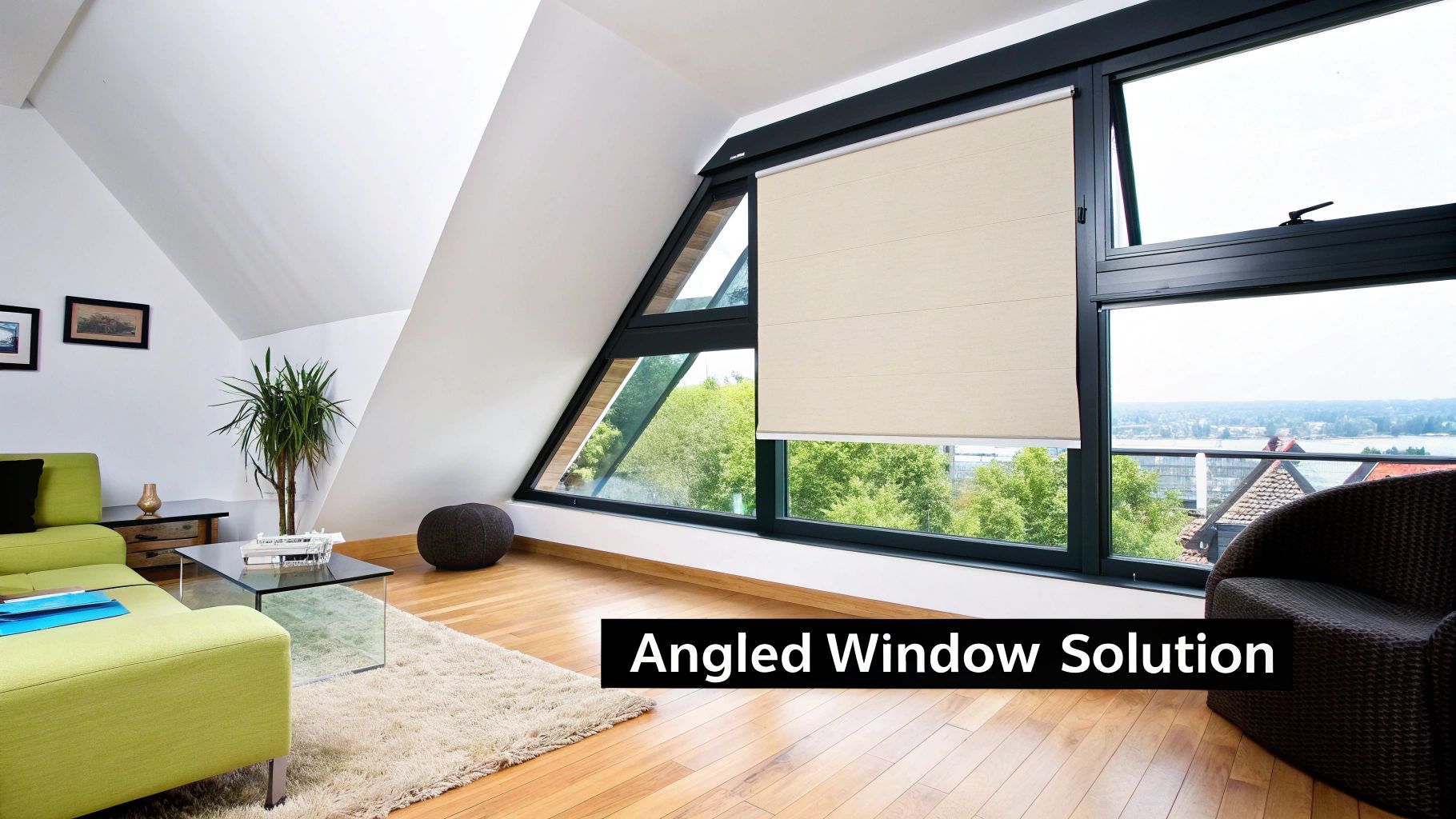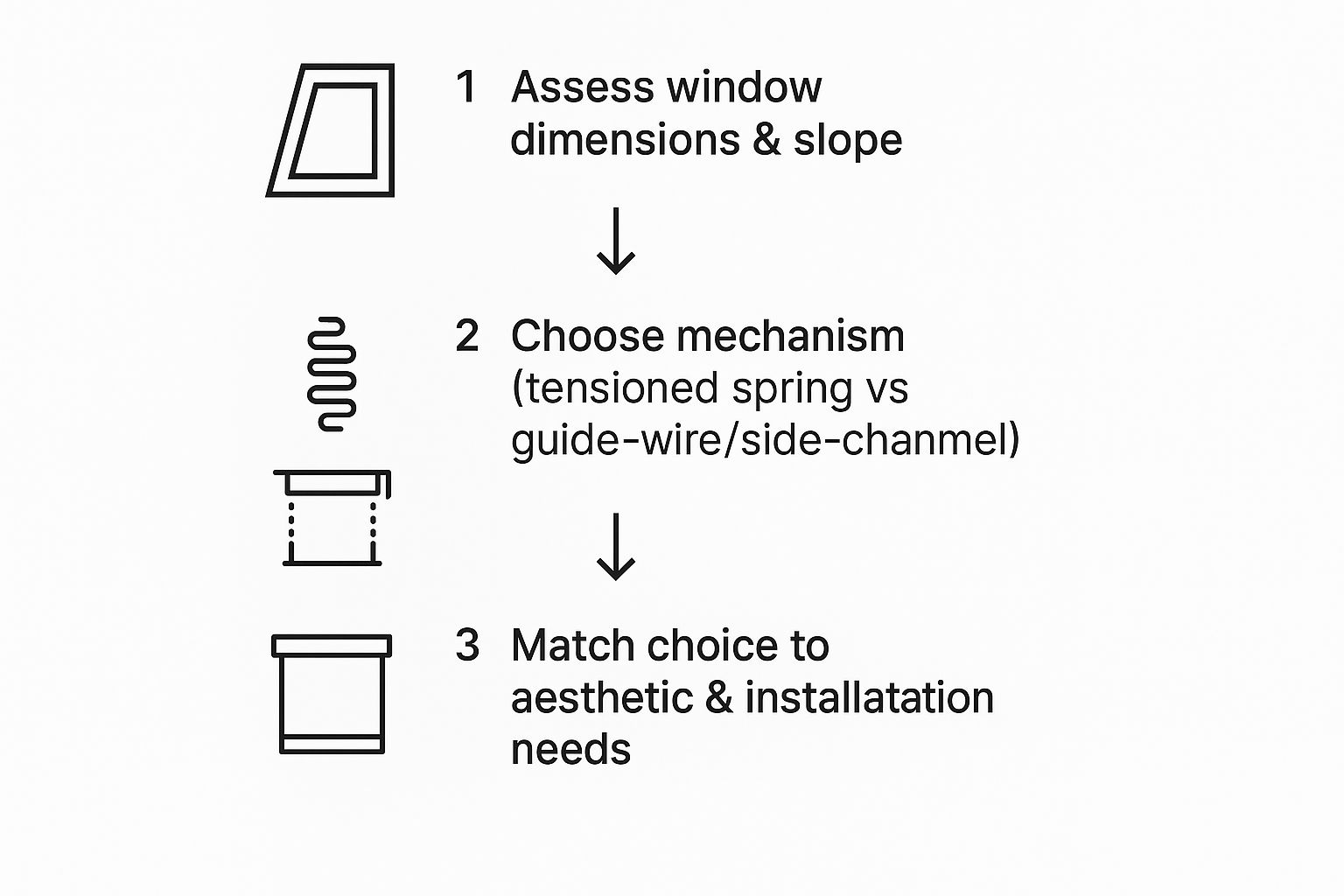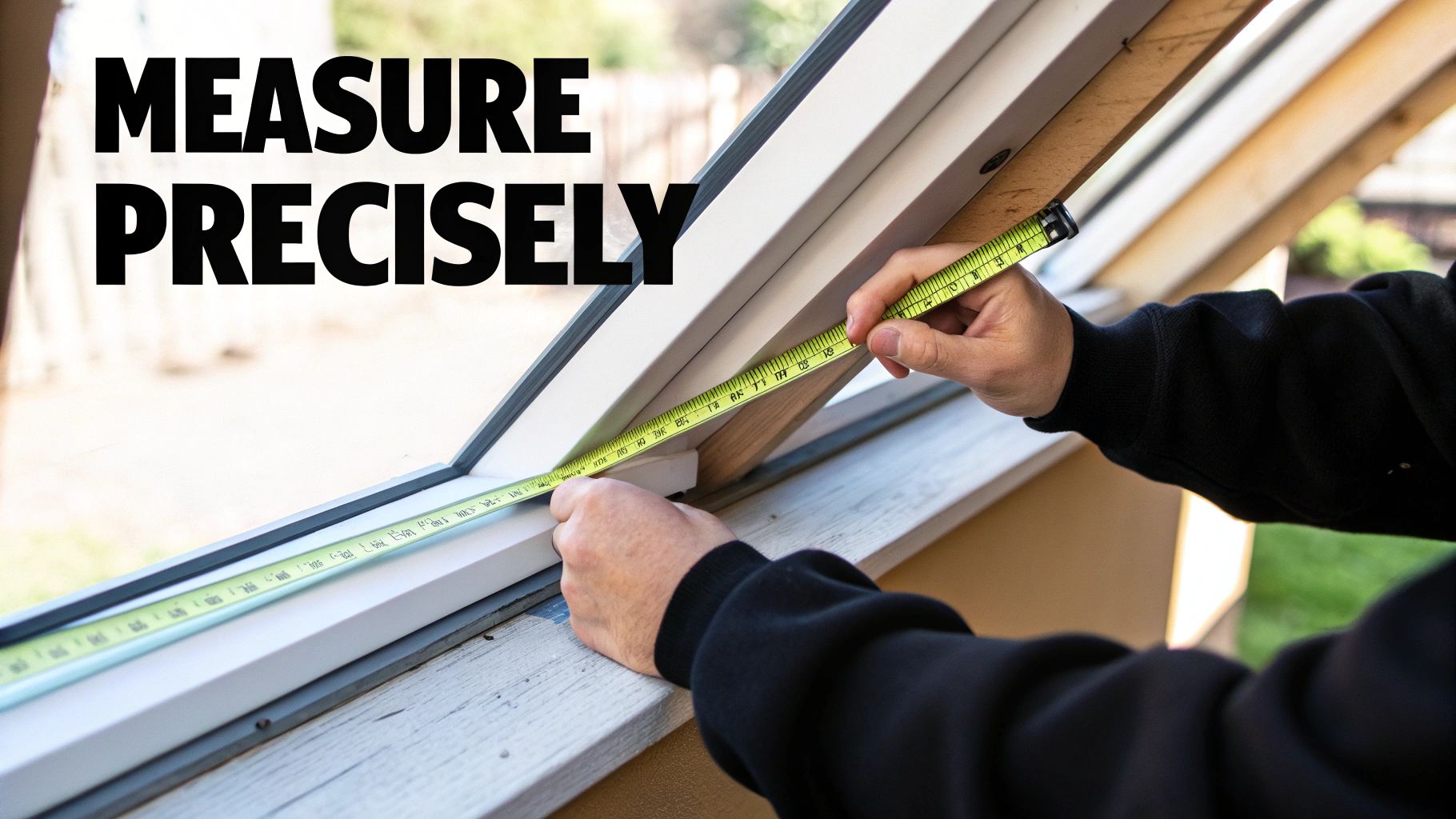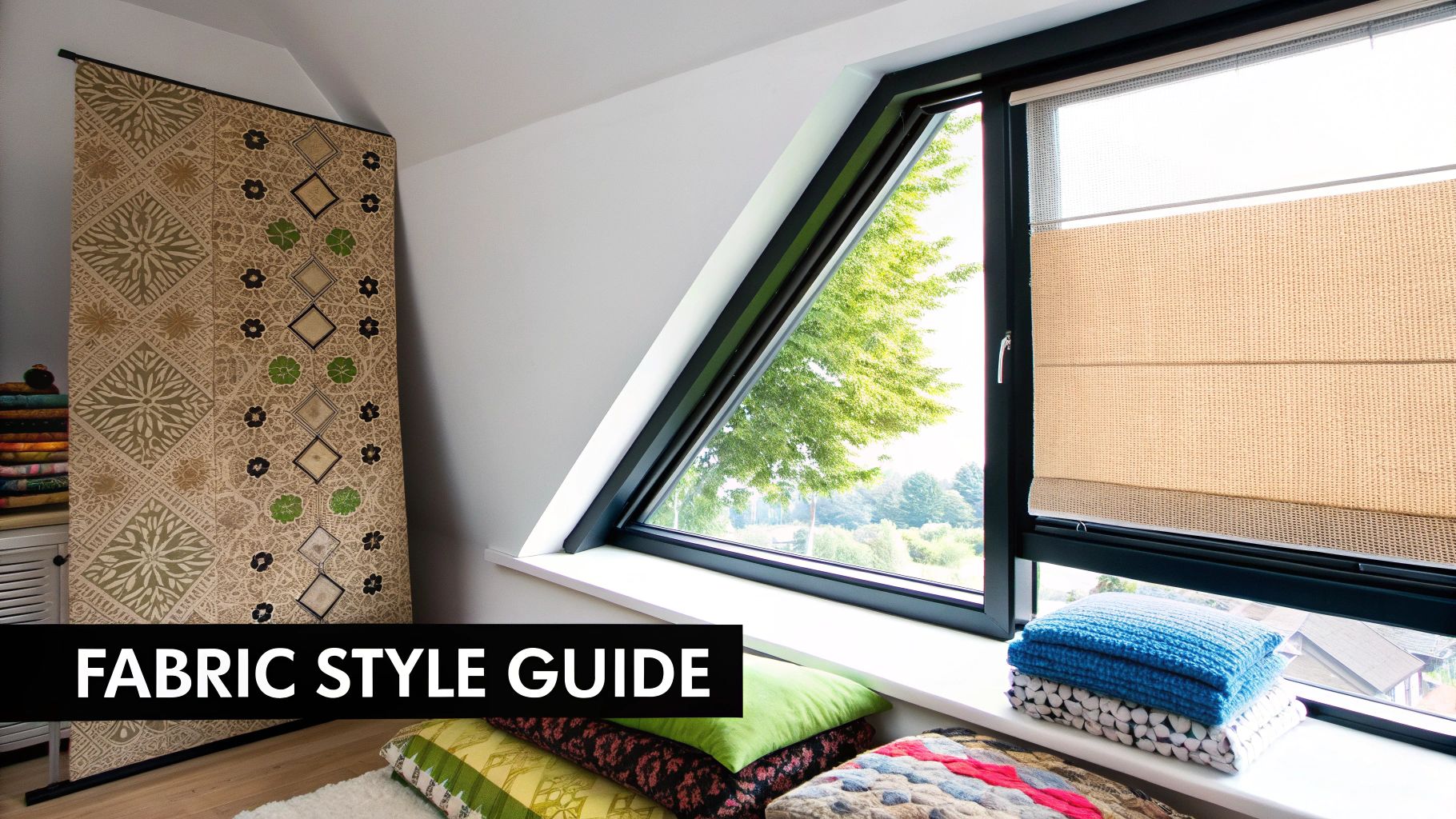A Practical Guide to Roller Blinds for Angled Windows
- Blindsmart im
- Oct 21
- 13 min read
Yes, you absolutely can get roller blinds for angled windows. It's a common question I get asked, and the answer is a definite yes—as long as you go for a custom-made system. These aren't your standard, off-the-shelf blinds; they use special tensioned mechanisms or guide wires designed to follow the unique slope of your window perfectly, ensuring they fit and operate smoothly where a normal blind would simply hang uselessly.
Solving the Angled Window Dilemma
Angled and sloped windows are fantastic architectural features. You often see them in modern extensions, converted lofts, and homes with stunning vaulted ceilings. They’re brilliant at flooding a room with natural light and making the space feel open and airy. But that unique charm brings a practical headache: how on earth do you cover them?

Standard blinds rely on gravity to hang straight, which just doesn't work for a window that slants. This is exactly where specialised roller blinds for angled windows come into their own. Unlike the ones you buy off the shelf, these are properly engineered systems designed to defy gravity and hug the glass.
Why Custom Systems Are Essential
A custom-made roller blind is built from the ground up to match the exact dimensions and slope of your window. This isn't just about looking good; it's about making sure the blind actually works. These systems use clever mechanisms to keep the fabric taut and in place, no matter the angle. This means they'll glide smoothly without sagging, catching, or becoming stuck halfway.
Going for a tailored solution brings some major benefits:
Complete Light Control: You can finally manage that afternoon glare, protect your furniture from UV fading, and create a comfortable atmosphere day or night.
Enhanced Privacy: Angled windows, especially in attic conversions, can sometimes offer an unwanted view into your home. Custom blinds give you full coverage when you need it.
Improved Insulation: A well-fitted blind adds an extra layer against the glass, helping to keep your room warmer in winter and cooler in the summer.
This level of bespoke fitting is becoming more and more common. In the UK, we're seeing a real growth in demand for these kinds of adaptable window treatments, driven by modern architectural trends. In fact, customised solutions for angled windows now account for roughly 10-15% of all our roller blind installations, which really shows how vital they've become in contemporary homes.
The biggest mistake I see homeowners make is trying to bodge a standard blind to fit a sloped window. Specialised systems with guide wires or tensioned springs aren't a luxury—they are the only way to get a result that works properly, looks great, and will last for years.
While angled windows present a unique puzzle, it's one that's far from unsolvable. The same idea of using tailored solutions applies to other non-standard shapes, too. For instance, our guide on https://www.blindsmart-im.co.uk/post/the-ultimate-guide-to-blinds-for-round-windows explores how customisation is the key to dressing any unusually shaped opening in your home.
At the end of the day, the right roller blind doesn't just cover your angled window; it celebrates its unique shape while delivering the performance you need.
Choosing the Right Blind System for Your Space
Once you’ve got your measurements sorted, picking the right operating system for your roller blinds for angled windows is the single most important decision you'll make. Unlike a standard vertical window, an angled one needs a mechanism that can actively defy gravity to keep the fabric tight and flush against the glass. If you get this wrong, you’ll end up with a saggy, sloppy-looking blind that just doesn’t work.
There are really two main players on the field for this kind of job: tensioned spring systems and guided systems. Each has its own set of pros and cons, and the best one for you will depend on the size and slope of your window, as well as the look you’re going for.
Tensioned Spring Roller Blinds
A tensioned spring system is quite a clever bit of engineering. At its heart is a powerful, pre-wound spring tucked inside the roller tube itself. This spring is always trying to pull the fabric back, which is what keeps it perfectly taut against the windowpane, no matter the angle.
I’ve found this mechanism works beautifully for smaller to medium-sized angled windows, like the ones you often see in loft conversions or skylights. Its biggest selling point is how discreet it is—you barely even notice it's there.
Minimalist Look: Because there are no visible wires or chunky side channels, all the attention is on your chosen fabric and the view.
Effortless Feel: The spring does a lot of the work, so opening and closing the blind feels smooth and controlled.
Highly Adaptable: It’s a great fit for a wide variety of slopes, as long as the window isn't exceptionally large or the fabric too heavy.
Guided Roller Blind Systems
Now, if you're working with much larger or more dramatic angled windows—think of a big gable end or a feature window in a modern extension—you'll need something more robust. That’s where a guided system comes in. These use either slim guide wires or solid side channels to hold the fabric securely in place from top to bottom.
Wire-Guided Systems use thin, high-tensile steel wires running down each side. The blind’s bottom bar is fitted with small eyelets that glide along these wires, keeping everything perfectly straight and preventing any bowing. They strike a nice balance between providing solid support and maintaining a relatively low-profile appearance.
Side-Channel Systems are the ultimate solution for stability and light control. With these, we install slim aluminium tracks down the sides of the window frame, and the fabric runs neatly inside them. This completely seals the blind around the edges, which not only stops any movement but also gives you fantastic blackout results.
To help you decide, let's break down how these systems compare and where each one truly shines.
Angled Roller Blind System Comparison
Choosing the right mechanism is all about matching the hardware to the specific demands of your window. This table lays out the key differences to help you pinpoint the best fit for your home.
System Type | Best For | Operating Mechanism | Key Advantage |
|---|---|---|---|
Tensioned Spring | Small to medium skylights and angled windows. | A powerful spring inside the roller tube maintains constant fabric tension. | A clean, minimalist aesthetic with no visible guide wires or channels. |
Wire-Guided | Large angled windows where a discreet look is still desired. | Fabric is guided by thin, high-tensile steel wires on each side. | Good stability for larger blinds without adding visual bulk. |
Side-Channel | Gable ends, blackout requirements, and maximum stability. | Fabric runs within fixed aluminium channels on the window frame. | Total light blockage and prevents any fabric movement or sagging. |
Ultimately, the goal is to find a system that not only works flawlessly but also complements your interior design. Whether you prioritise an invisible mechanism or maximum light control, there’s a solution that will feel like it was designed just for your window.
The infographic below helps to visualise this decision-making journey, showing how the window's own characteristics should guide your choice.

It’s clear that homeowners in the UK value durable and reliable solutions. Recent market reports show that blinds command a 60% revenue share of all window coverings, and roller blinds are leading that charge. For roller blinds for angled windows in our changeable climate, aluminium components are a popular choice as they don’t warp or fail on unconventional window shapes. You can explore more about these trends in reporting on the external blinds market from Future Market Insights.
How to Measure Angled Windows Like a Pro
Getting your measurements right is everything when it comes to blinds. For a standard square window, it’s a doddle. But throw a slope or a triangle into the mix, and you need to be much more deliberate. A few millimetres off, and you’ll instantly see it – the difference between a custom, high-end finish and a blind that just looks… wrong.

This isn’t the time for guesswork. There’s a golden rule all professional installers follow, and it’s beautifully simple: measure everything at least twice. And please, use a proper steel tape measure. Those fabric ones can stretch over time and throw your numbers off completely.
Gathering Your Key Dimensions
For roller blinds for angled windows, a simple width and height just won't cut it. Your supplier needs the full story of your window's geometry to craft something that fits perfectly. Let’s walk through exactly what you need to get.
First, grab a piece of paper and sketch the rough shape of your window. It doesn't need to be an architectural drawing, just a clear map for you to jot down your numbers against the right lines.
For most angled windows, you’ll be measuring the following:
Top Width: The straight, horizontal distance across the very top of the window frame.
Bottom Width: Same again, but the straight, horizontal measurement across the bottom.
Vertical Height (Long Side): The height of the window at its tallest point, from top to bottom.
Vertical Height (Short Side): For a trapezoid shape, this is the height of the shorter vertical side. If you've got a triangle, this will obviously be zero.
Diagonal Slope Length: This one is crucial. Measure the full length of the sloped side of the frame itself.
A quick tip from the trade: for all your width and height measurements, take them in three different spots (e.g., left, centre, and right for the width). Always give your supplier the smallest of the three readings. This little trick accounts for any slight variations in your window recess and guarantees the blind won’t catch or drag.
The Cardboard Template Trick
Sometimes, a window has a funny curve or a unique angle that’s hard to capture with numbers alone. In these tricky situations, there's an old-school method that has never failed me: making a template.
Find a big piece of cardboard – an old delivery box is perfect. Hold it flat against the window and carefully trace the inside shape of the frame onto it. Cut it out, and you've got a perfect physical copy of your window.
This template is worth its weight in gold. You can lay your tape measure on it to double-check your figures, and some suppliers will even let you post it to them. It removes all doubt and ensures the blind is made to the exact, unique shape you need. It's a small extra step that makes a huge difference.
Inside vs Outside Recess Fitting
Lastly, you need to decide where the blind will hang. Will it be tucked neatly inside the window opening (recess fit) or mounted on the wall around it (exact fit)? This decision changes how you measure.
Inside Recess: For that clean, integrated look, all your measurements should be taken from within the window frame. Don't forget to measure the depth of the recess, too. You need to be sure there’s enough room for the blind mechanism to sit comfortably without sticking out.
Outside Recess: If you're mounting the blind on the wall, you need to add a bit of an overlap for better light blocking and privacy. As a rule of thumb, I always recommend adding at least 70mm to each side, top and bottom, for full coverage.
Giving these precise measurements to your supplier is the most important part of the whole job. You’re handing them the blueprint for a blind that will not only fit like a glove but also work flawlessly for years.
A Realistic Guide to Installing Your Blinds
With your custom-made blind in hand, the final piece of the puzzle is getting it up on the wall. This isn’t a technical manual packed with jargon; it's a practical, real-world walkthrough to help you get your new roller blinds for angled windows perfectly fitted. Honestly, getting this part right is what makes a good blind look great.
First things first, let’s talk tools. You don’t need a massive workshop, just a handful of essentials. A quality steel tape measure, a pencil, a spirit level, and a reliable drill are your best friends here. Make sure you've got the correct drill bits for your wall type – drilling into masonry is a world away from plasterboard. A sturdy step ladder is also non-negotiable for your safety.
Preparing Your Workspace
Before a single hole is drilled, take a moment to prep the area. Clear away any furniture, plants, or ornaments from under the window. This gives you plenty of space to work safely and stops you from accidentally knocking anything over.
I’d also strongly recommend laying down a dust sheet. It might seem like a hassle, but it’ll save you a ton of time on clean-up later.
Now, carefully unpack your blind. Lay all the components out and check them against the parts list that came with it. It’s far better to spot a missing screw now than when you're halfway up a ladder with the blind in one hand.
Mounting the Brackets Correctly
This is where precision really counts. Mounting the brackets is arguably the most crucial step, especially for a sloped window.
Start by holding your first bracket in position in one of the upper corners of the frame. Grab your spirit level and make absolutely sure it’s perfectly horizontal before marking the drill holes with your pencil.
A quick pro tip: Always drill small pilot holes before driving the screws in. This simple action prevents the wood from splitting and gives the screws a much cleaner, more secure grip. It’s one of those small details that makes a massive difference to the final strength of the installation.
Once the first bracket is securely attached, just repeat the process for the other side. Always double-check your horizontal alignment with the spirit level before you start drilling the second set of holes. If you've ordered a particularly wide blind, it might have come with a central support bracket – your instructions will tell you if you need one.
Securing the Blind and Guide Wires
With the brackets firmly in place, you can now carefully click the roller blind cassette into them. You should hear and feel it snap in securely. Now it’s time to tackle the guide wires or side channels if your system has them. These are the clever bits that keep the fabric taut and stop it from sagging on the angle.
Attach the top of the guide wires to the headrail or cassette as shown in your instructions. Next, gently pull them down to the bottom corners of the window frame. You’ll need to install small tension brackets here to hold the wires taut.
The key is to get the tension just right – it must be firm, but not overly tight. Too much tension puts unnecessary strain on the whole system.
Finally, give it a test run. Gently pull the blind up and down a few times. Watch to see that it glides smoothly without catching or snagging anywhere. You're looking for the fabric to remain tight against the glass at all points of its travel. While the principles are similar for many blind types, our practical DIY guide for Venetian blinds offers more insights into the general installation process, which you might find helpful.
Make any tiny adjustments to the wire tension as needed until you have a flawless finish.
Choosing Fabrics for Function and Style
The mechanical system of your roller blinds for angled windows is only half the story. The fabric you choose is what truly brings the solution to life, dictating the room's atmosphere, functionality, and overall aesthetic. This isn't just about picking a colour you like; it’s about matching the material to the room's purpose.

Think about a living area with a beautiful view from a gable window. You almost certainly don't want to block it out completely. A sheer or voile fabric is an excellent choice here. It softens harsh sunlight, cuts down on glare, and provides daytime privacy, all while letting you enjoy the scenery outside. It’s perfect for transforming direct, intense light into a gentle, diffused glow.
Balancing Light and Privacy
In other spaces, like a bedroom or a home cinema, your priority will be the exact opposite: maximum light control. This is where blackout fabrics come into their own. Thankfully, modern blackout materials are a world away from the stiff, heavy options of the past and now come in a huge range of colours and textures.
A common misconception is that blackout fabrics must be black. In reality, the light-blocking layer is bonded to the back, so you can have a crisp white or a vibrant pattern facing the room while still achieving total darkness.
For the ultimate in both light control and energy efficiency, it's worth exploring specialist materials. Our guide on thermal blackout roller blinds for home comfort dives deeper into how these advanced fabrics can make a real difference to your home's bills and comfort levels.
Making a Style Statement
Of course, your fabric choice is also a key design decision. Do you want your unique angled window to be a standout architectural feature, or would you prefer it to blend seamlessly with your decor?
For a Feature Window: Choose a bold colour or a striking pattern. This draws the eye and turns the window into a deliberate focal point. I've found that geometric prints can look particularly effective on triangular or trapezoidal shapes.
For a Subtle Look: Opt for a neutral tone that matches your wall colour. This creates a cohesive and understated effect, allowing other elements in the room, like furniture or artwork, to take centre stage.
Ultimately, picking the right fabric enhances both the performance of your blind and the personality of your room. It’s that final touch that ensures your angled windows are as practical as they are beautiful.
Got Questions About Angled Window Blinds? We’ve Got Answers
Stepping into the world of specialist window treatments can feel a bit daunting, and it's only natural to have a few questions. When you're dealing with something as unique as roller blinds for angled windows, it’s smart to get all the facts straight before making a decision.
We've pulled together the most common queries we hear from homeowners, so you can get clear, straightforward answers and feel confident about your choice.
Can Angled Roller Blinds Be Motorised?
Yes, they absolutely can! In fact, motorisation is often the most practical choice for these kinds of windows. We highly recommend it for any angled window that's high up, like those in a vaulted ceiling, or just awkward to get to. Think about the hassle of manually adjusting a blind on a tall gable-end window every single day.
A motorised system takes all that effort away. You can operate your blind with a simple remote, a wall switch, or even an app on your phone. It adds a level of convenience that turns a tricky window into one of your home’s best features.
Are There Size Restrictions for Angled Roller Blinds?
There are, yes. Every system has its own operational limits. Manufacturers specify maximum and minimum dimensions based on the strength of the internal components and the weight of the fabric you choose.
If you have a particularly large or wide angled window, it might need a more heavy-duty system. Another great solution is to install a couple of blinds side-by-side, which can create a really seamless look while ensuring everything works perfectly.
This is why providing your supplier with precise measurements is so important. It lets them confirm their system is right for your window and recommend the most reliable option for the job.
How Do You Clean and Maintain Blinds on a Sloped Window?
You’ll be pleased to hear that maintenance is surprisingly straightforward. For day-to-day upkeep, a quick going-over with a feather duster or the soft brush attachment on your vacuum is usually all it takes to keep the fabric looking fresh.
If you spot a small stain, you can usually tackle it with a damp cloth and some mild soap. Just be sure to check the manufacturer’s care instructions first to be safe. The biggest challenge, of course, is simply reaching them. For high-up windows, you’ll need a sturdy ladder or a cleaning tool with an extendable handle to get the job done safely.
Ready to find a hassle-free solution for your angled windows? The team at Blindsmart is here to help you measure, choose, and install with confidence. Explore our custom-made options at https://www.blindsmart-im.co.uk.
